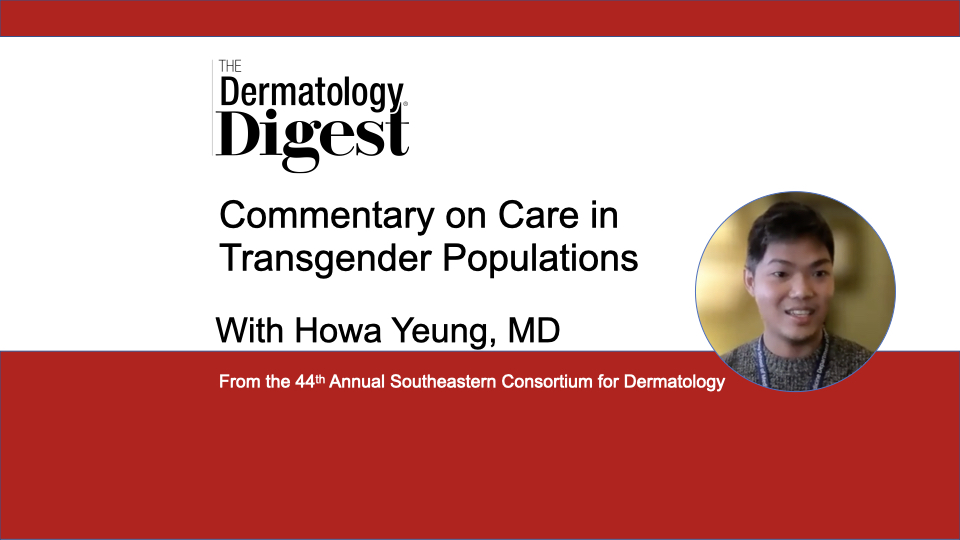Dr. Howa Yeung discusses skin health, treatment needs, and approaches for transgender care in the dermatology practice.
Howa Yeung, MD is Assistant Professor at Emory University School of Medicine in Atlanta, Georgia.
“In the past, people [didn’t] think that we should treat anyone any differently. Everybody should just be treated the same, so why should I care whether someone identifies as transgender? But we increasingly recognize that there’s important health disparities and health concerns that disproportionately affect trans populations,” said Howa Yeung, MD, who presented “Care in Transgender Populations” at the 44th Annual Southeastern Consortium for Dermatology.
According to Dr. Yeung, the number of people who identify as LGBTQ (Lesbian Gay, Bisexual, Transgender and Queer or Questioning) is growing, and as this population becomes more visible it becomes increasingly important for the dermatologist to be aware of and able to address specific issues related to skin health, treatment needs, and approaches.
“One of the latest estimates of LGBTQ population shows that 5.6% of all US adults identify as LGBTQ, and that’s on the rise.”
In younger age groups, nearly 10% of millennials and 17% of Gen Z identify as LGBTQ; 1.2% of millennials and 1.8% of Gen Z identify as transgender, he said.
“That’s a huge slice of the US population, but most dermatologists have not historically learned about how to best care for [the] LGBTQ population.”
In terms of skin health, various gender-affirming treatments can have undesirable effects on the skin, such as hormones causing acne, and patients may downplay this and other side effects, said Dr. Yeung.
“A lot of trans patients are so grateful that they finally have access to gender affirming testosterone, for example, that [they] underplay the importance of the skin side effects because they don’t want you to take away their hormones. But it’s really important to understand that these skin side effects are… treatable and they are something that dermatologists can really play a strong role in mitigating… as well as improving the overall outcome of these hormone therapies, for example.”
Dermatologists should also be aware of the limitations of some treatments, such as estrogen or anti-androgen hormone therapies.
“For example, a lot of trans women will still have some facial hair growth that [is] really distressing… and dermatologists have a really important role in providing permanent hair removal procedures that are very gender affirming that truly impact people’s lives.”
Dr. Yeung emphasized the role dermatologists play in providing safe neurotoxin and dermal filler injectable treatments as part of the gender-affirming process as well.
“For patients who have not historically had access to fillers to their cheeks, some trans women have resorted to getting illicit [silicone and other] filler injections… which done by unlicensed providers… [can] cause a lot of devastating side effects, whether it is silicone granulomas, which can be very painful and disfiguring, but also some of the silicone might actually migrate to say the lungs and cause pulmonary embolism.”
And while hair removal and injectable treatments are generally considered cosmetic, Dr. Yeung said not so for treatments when performed for gender affirmation.
“It’s important to recognize the medical necessity for a lot of the dermatologic care that we provide.”
The World Professional Association for Transgender Health describes many gender affirming/confirming procedures as medically necessary, including facial hair removal.1
“So some of these things that we do, which historically have been considered aesthetic or cosmetic, are really medically necessary for trans folks and really create an important, positive mental health impact for these patients.”
In his presentation, Dr. Yeung highlighted data2 showing transgender hair removal patients were about one-third less likely to have severe psychological distress or suicidal ideation the year following treatment.
“We should not assume that just because things affect people on the outside that we’re not providing important care for the patients.”
References
- “Position Statement on Medical Necessity of Treatment, Sex Reassignment, and Insurance Coverage in the U.S.A.” World Professional Association of Transgender Health (WPATH). Available at: https://www.wpath.org/newsroom/medical-necessity-statement. Accessed December 9, 2021.
- Lee MS, Almazan AN, Nambudiri VE, Keuroghlian AS. Association Between Gender-Affirming Hair Removal and Mental Health Outcomes. JAMA Dermatol. 2021 Sep 1;157(9):1120-1122. doi: 10.1001/jamadermatol.2021.2551. PMID: 34287625; PMCID: PMC8295891.


